
Observation – The Senseless Loss of Inisfada
INISFADA – Manhasset, North Hempstead, Nassau County, New York
Buckle up Buttercups – I’m in a real mood – angry, frustrated and most of all disheartened – Again! In all honesty, it’s a mood that started in late 2013 (yes, I do tend to fester over these things!), but this mood has been recently reawakened. This diatribe may very likely be the first of several rants or verbal installments on this particular topic (Hell, I could create an entirely separate website on this subject alone – maybe call it “people and things that piss me off”, but I’m sure that domain is already taken.)
What prompted my “mood resurgence” was a link I came across over the weekend from a video blogger by the name of Ethan Minnie who has his own YouTube channel in which he explores abandoned/ vacant mansions. Have a look at Ethan’s walk through of the home here. This mansion is in Toronto’s tony Bridle Path neighbourhood, which is well known as the location for the wealthy to build vanity projects, (built, rarely occupied, sold, leveled, and then rebuilt by the next guy, etc. etc., etc.).
As is a common occurrence, the home at 68 The Bridle Path, was purchased by foreign investors, who have no tie to (or respect for) an area’s-built heritage, and had the home unceremoniously razed in the name of profit. This action is of course with the intent of either flipping the now vacant building site or of building yet another nondescript Beverly Hillbilly’s type granite knock off to sell to other foreign investors, who will inevitably never move in. Although this was not a historical mansion, (it was constructed in 1985 for real estate developer Robert Campeau), it was a beautiful home, and represents to me the loss of an opportunity to salvage and repurpose some beautiful features of the home for someone new to enjoy, rather than creating more unnecessary landfill.
Ethan’s YouTube walk through of this house and its subsequent demolition brought back my gut-wrenching reaction to the senseless destruction of Inisfada, the North Hills, Long Island estate of Nicholas Frederic Brady and Genevieve Brady.
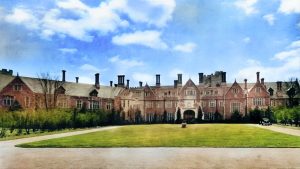 Inisfada was constructed from 1916 to 1920 at a cost of over $2 million ($56 mill in today’s dollars) by the wealthy industrialist Nicholas Brady as a tenth wedding anniversary gift to his beloved wife, Genevieve Garvan Brady – not a bad gesture if you ask me. Inisfada (which is Irish for “Long Island”) was once the fourth-largest mansion in the United States, larger even than The Breakers and Hearst Castle. Not only were the Brady’s extremely wealthy, but the couple were also inducted as Papal Duke and Duchess by Pope Pius XI in 1926 in appreciation of their substantial donations to the Catholic church, (which included a gift of over $12 million to the Vatican itself). They were notably the first (and last) Papal Duke and Duchess of America, which apparently are titles available for purchase from the church for the small donation of $12 mill to the Vatican (BTW, if you do the conversion, $12 mill in 1926 is over $336 mill in today’s dollars – I would have seriously considered blessing them myself for that kind of dough!)
Inisfada was constructed from 1916 to 1920 at a cost of over $2 million ($56 mill in today’s dollars) by the wealthy industrialist Nicholas Brady as a tenth wedding anniversary gift to his beloved wife, Genevieve Garvan Brady – not a bad gesture if you ask me. Inisfada (which is Irish for “Long Island”) was once the fourth-largest mansion in the United States, larger even than The Breakers and Hearst Castle. Not only were the Brady’s extremely wealthy, but the couple were also inducted as Papal Duke and Duchess by Pope Pius XI in 1926 in appreciation of their substantial donations to the Catholic church, (which included a gift of over $12 million to the Vatican itself). They were notably the first (and last) Papal Duke and Duchess of America, which apparently are titles available for purchase from the church for the small donation of $12 mill to the Vatican (BTW, if you do the conversion, $12 mill in 1926 is over $336 mill in today’s dollars – I would have seriously considered blessing them myself for that kind of dough!)
In March of 1930, Mr Brady died suddenly at the young age of 52 from complications from a painful malady of the spine. Genevieve died shortly there after in 1938 at the young age of 58. Having no children, she bequeathed Inisfada, its contents, and the surrounding 330 acres of prime North Shore real estate to the New York Province of the Catholic Society of Jesus (The Jesuits) order for their use as a seminary, which continued until 1963, at which time they began operating Inisfada as the St. Ignatius Retreat House.
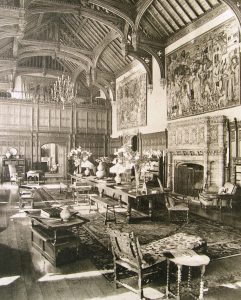 On June 21, 2012 the Provincial of the Jesuits (Fr. David Ciancimino) announced by letter that Inisfada and another local Jesuit retreat house, the Mount Manresa Jesuit Retreat House in Staten Island, would be closed on June 1, 2013, noting that the retreat house model was no longer financially viable or consistent with their new vision. This change in direction I honestly have no issue with – hey, things never stay the same, needs must adjust with changing times, and finances often become an issue. What I do have an issue with however is that even the Catholics (yea, yea, I know) put profit ahead of heritage and the desires of their benefactors.
On June 21, 2012 the Provincial of the Jesuits (Fr. David Ciancimino) announced by letter that Inisfada and another local Jesuit retreat house, the Mount Manresa Jesuit Retreat House in Staten Island, would be closed on June 1, 2013, noting that the retreat house model was no longer financially viable or consistent with their new vision. This change in direction I honestly have no issue with – hey, things never stay the same, needs must adjust with changing times, and finances often become an issue. What I do have an issue with however is that even the Catholics (yea, yea, I know) put profit ahead of heritage and the desires of their benefactors.
In 2012, the Manhasset Press reported that the Jesuits put the house and its remaining 33-acres on the market for $49 million, advertising Inisfada as, “a prime development site”. As a Note, the Jesuits had been gradually selling off the land to developers since receiving the 1938 gift, reducing the original 330 acres they were bequeathed to the 33 acres immediately surrounding the mansion.
Lets back up a bit and describe the house that was gifted to the Jesuits.
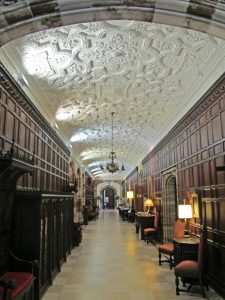 As with many wealthy industrialists of the day, the Brady’s desired a summer home as an escape from their main New York home at 910 Fifth Avenue, and of course their winter place, Casa del Sole at 16 via Aurelia Antica in Rome. To construct their Tudor-Elizabethan Revival mansion, the Bradys employed Philadelphia architect John Torrey Windrim (1866-1934) best known for his work on large-scale buildings, court houses, police departments, museums, and hospitals, as well as designer Samuel Bowne Parsons Jr. (1844-1923) for the landscaping. The eighty-seven room, ninety-thousand square-foot brick mansion was trimmed in limestone, which was carved into a chaotic variety of quoins, crenellations, gargoyles, and (for reasons I have yet to understand from childless builders), numerous carved stone characters from nursery rhymes and childhood fairy tales. This colossus was capped by an enormous and complex gabled, slate roof, punctuated with 37-Tudor-style chimneys, each one different from the next.
As with many wealthy industrialists of the day, the Brady’s desired a summer home as an escape from their main New York home at 910 Fifth Avenue, and of course their winter place, Casa del Sole at 16 via Aurelia Antica in Rome. To construct their Tudor-Elizabethan Revival mansion, the Bradys employed Philadelphia architect John Torrey Windrim (1866-1934) best known for his work on large-scale buildings, court houses, police departments, museums, and hospitals, as well as designer Samuel Bowne Parsons Jr. (1844-1923) for the landscaping. The eighty-seven room, ninety-thousand square-foot brick mansion was trimmed in limestone, which was carved into a chaotic variety of quoins, crenellations, gargoyles, and (for reasons I have yet to understand from childless builders), numerous carved stone characters from nursery rhymes and childhood fairy tales. This colossus was capped by an enormous and complex gabled, slate roof, punctuated with 37-Tudor-style chimneys, each one different from the next.
Within the building, Windrim ensured all the necessary accoutrements required of a wealthy country house were included in the structure, including a solarium, billiard room, library, study, dining room, breakfast room, wine cellar, living rooms, receiving rooms, etc. all connected by a 163 foot long, walnut paneled axis hall, a dozen staircases (including numerous hidden staircases), an elevator and the estates own 89 extension telephone network. For the finishing, Windrim sourced the world’s finest artisans and crafts people to mold high plasterwork ceilings, hand carved fluted ionic pilasters, stone columns, oak wall-paneling, and the magnificent bannisters on the Grand Staircase. The bathrooms housed gold-plated plumbing fixtures; the Dining Room was paneled in late 17th century pine; and, the Great Hall was capped with a 50-foot high, arched and beamed ceiling, musician’s gallery and an Aeolian organ (one of two in the house).
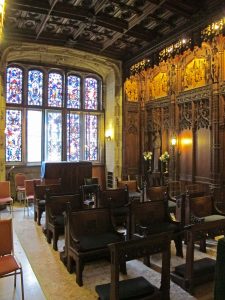 What differed this home from similar homes being built at the time, was the inclusion of a private chapel and sacristy, which contained the second of the home’s organs. This organ dedicated solely to leading mass; a daily event led by a priest retained solely for this purpose. This room featured carved oak walls and ceiling, intricate stained-glass windows and a rare Siena rose altar under an intricately carved and gilded wood canopy. As with any major cathedral worth its salt, the Brady’s chapel housed its own reliquary containing relics of various saints and two certified relics of the true Cross, authenticated to be from the actual cross used in the crucifixion of Jesus (according to Christian tradition), although I have no idea what scientific methods could have been deployed in the authentication. These priceless artifacts were gifted to the Brady’s by their many close religious’ friends and dignitaries.
What differed this home from similar homes being built at the time, was the inclusion of a private chapel and sacristy, which contained the second of the home’s organs. This organ dedicated solely to leading mass; a daily event led by a priest retained solely for this purpose. This room featured carved oak walls and ceiling, intricate stained-glass windows and a rare Siena rose altar under an intricately carved and gilded wood canopy. As with any major cathedral worth its salt, the Brady’s chapel housed its own reliquary containing relics of various saints and two certified relics of the true Cross, authenticated to be from the actual cross used in the crucifixion of Jesus (according to Christian tradition), although I have no idea what scientific methods could have been deployed in the authentication. These priceless artifacts were gifted to the Brady’s by their many close religious’ friends and dignitaries.
Despite the efforts of various residents and civic associations to save Inisfada, the Jesuits sold the property in 2013 for $36.5 million to the Hong Kong-based development company, Manhasset Bay Group Inc. On December 5, 2013, Inisfada was unceremoniously demolished to make way for a proposed 46 home residential subdivision on the property.
Changing their minds, the Hong Kong investors listed and sold the now vacant property on Nov 19, 2021 for $38,400,000, having realized a profit of $1.9 million from their December 6, 2013 $36.5 million purchase of the property. This $1.9 mill of course would be lessened by the costs associated with legal and real estate fees, bank carrying charges, taxes … oh and the costs to demolish an irreplaceable architectural masterpiece. Bastards!
John Foreman in his blog “Big Old Houses” created a beautiful room by room walk through of Inisfada prior to its demolition which you can view here.
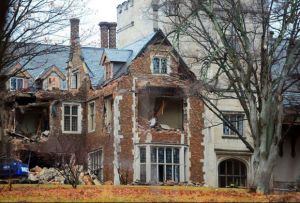 There have been many (MANY) homes over time which have been demolished in the name of progress, and to be honest, most cities could not be where they are today had they not built, demolished, built bigger and better and demolished again – it is as the term implies “progress”. AND, I must accept the fact (and through therapy, I have) that many buildings considered historical now, were not appreciated then and were seen only as out of date, ostentatious “White Elephants” or had deteriorated to such a state that they were no longer salvageable. These were also times when no one appreciated the artistic skills required to create these masterpieces – skills and trades which have long since vanished. However, every so often, there is a building of such magnificence, which, defeating all odds, has outlasted changing economic times, financial hardships and lifestyles and survived – in its original state no less. It is unfathomable then that in this day and age, greed still surpasses art, as these irreplaceable masterpieces continue to face the wrecking ball.
There have been many (MANY) homes over time which have been demolished in the name of progress, and to be honest, most cities could not be where they are today had they not built, demolished, built bigger and better and demolished again – it is as the term implies “progress”. AND, I must accept the fact (and through therapy, I have) that many buildings considered historical now, were not appreciated then and were seen only as out of date, ostentatious “White Elephants” or had deteriorated to such a state that they were no longer salvageable. These were also times when no one appreciated the artistic skills required to create these masterpieces – skills and trades which have long since vanished. However, every so often, there is a building of such magnificence, which, defeating all odds, has outlasted changing economic times, financial hardships and lifestyles and survived – in its original state no less. It is unfathomable then that in this day and age, greed still surpasses art, as these irreplaceable masterpieces continue to face the wrecking ball.
Many back woods towns are only known to the public solely as being the location of a Historic Mansion Museum, which also attracts valuable tourist dollars to the community. Lets be honest, why else would anyone ever want to visit some of these places (Ashville, NC (Biltmore) Auburn Hills, MI (Meadow Brook Hall)), or Fayette County, Pennsylvania (Falling Water) were it not for the opportunity to tour these mansions? I should know, having dragged my poor co-pilot to many of these obscure North American towns for the sole purpose of walking through these very homes. No offence of course for anyone out there who has a legit reason other than tourism to visit these often-remote municipalities. What I’m saying is, aside from the historic and educational value, the enormous financial benefits, and unlimited community and employment spinoffs of operating or adapting a Historic House Museum had been well established prior to the many conversations surrounding the saving of Isisfada. Simply put – tourism generated from a unique local attraction such as Inisfada provide unlimited demands for retail, restaurant and accommodation opportunities – i.e. LOCAL JOBS!
What an utterly senseless and unnecessary loss.
The ignorance and selfish greed exhausts me.